Varanasi – Braced in Belief
+ Join me on a photography tour to Varanasi. Nov 2015.
+ This article was earlier published in The LA Journal.
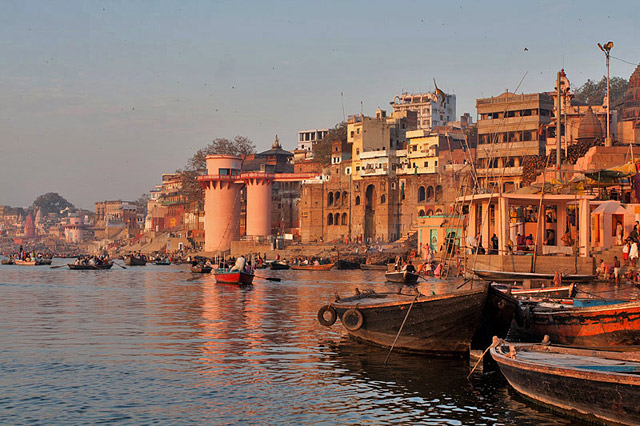
Standing in a corner of Prayag Ghat, I watched people come and go in thousands every hour in the evening of Maha Shivaratri. Pilgrims arrived at the ghats in larger than usual numbers, took a dip in the sacred river and headed towards Kashi Viswanath Temple. It was an assortment of a variety of people. There were chattering groups with an air of casualness of a tourist visiting a new place. There were grim faces that spoke of the hardships of life that one had gone through. Solemn elderly men moved in the crowds, chanting Har Har Mahadev. The pandas and traders eagerly offered their services to the pious pilgrims. The Ganges flowed gently, unmindful of the millions who trusted her for thousands of years to cleanse their souls. The ghats stretched for miles along the west bank, staying witness to the flow of emotions and spiritual quest, facilitating pilgrims in their journey of purification. The steps leading in to the river, the pointed towers of the temples spread along the shore and the round and grey canopy that sheltered the pandas, together dominated the panorama of the old city of Varanasi that had changed little over centuries as pilgrims of smorgasbord backgrounds came and went in their search for passage to a higher world. As the water flowed in the river over millenniums, the essence of the ghats had refused to grow with the times and had taken refuge in the unshakable spiritual belief of the common man.
The ghats have remained isolated to the progress in time, but the new Varanasi has little to share with the ancient town that spreads thinly along the river bank. Arriving by train and coming out of the station, I saw a vista that has little to distinguish itself from the urban sprawl of any modern Indian city. Big brands jostled for ad-space on the hoardings spread on either side of the wide roads. Malls, restaurants and plush hotels had taken up prime spaces and cajoled the consumers to spend freely. Cars whizzed past the slow cycle-rickshaw that carried me towards the old city and further to the ghats. What I was seeing was the stereotype urban Indian expanse. It made me wonder if the world’s oldest city was lost to the economic reforms that swept the country and changed its urban landscape.
The roads became narrower and the size of the buildings shrunk as my rickshaw driver pedaled slowly towards the old city. Large buildings gave way to smaller establishments. Cars disappeared from the road, making way for cycle-rickshaws and pedestrians. The galis leading out of the roads were barely wide enough to let in a man or two. I was now entering the quarters of the world’s oldest living city, a part of Varanasi that has never kept up with time. But the feeling of my first encounter was not the charm of the old times, but a gloom numbing my mind. It came from the dirt and grime that seemed to be integrated with the city’s oldness. It was sad to see the Holy Ganges to be no more than a half-mile wide sewer.
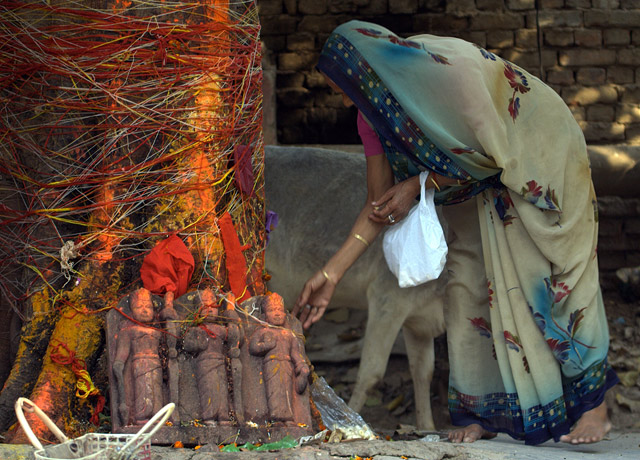
It is the ghats along the river that represent timelessness of Varanasi. In my days of strolling here, I saw the never ending series of steps along the river being home to a myriad of spiritual activities. Mendicants half immersed in the water made offerings to the Sun God. Groups of pilgrims were lead by priests to perform shraddha karma and pray, so that the souls of their ancestors may make safe passage to heaven. Bearded babas assumed a spiritual significance as they sat together and chain-smoke in a corner. Men meditated sitting cross legged on pedestals. Women came round a ficus tree and tied a turmeric coated thread around the trunk. People of all ages descended into the water and took the holy dip, folding their hands and praying to Ganga Ma. Pandas performed rituals and blessed the pilgrims in good faith. In the evenings, the Ganga Aarti at Dasaswamedh Ghat enthralled the visitors with an elaborate choreography supported by devotional choirs. Life and death were treated with equal indifference in Manikarnika and Harischandra Ghats as the earthly remains of the departed soul were half burned and thrust into the river, even as the tourists and pilgrim alike walked past with an evasive glance at the process.
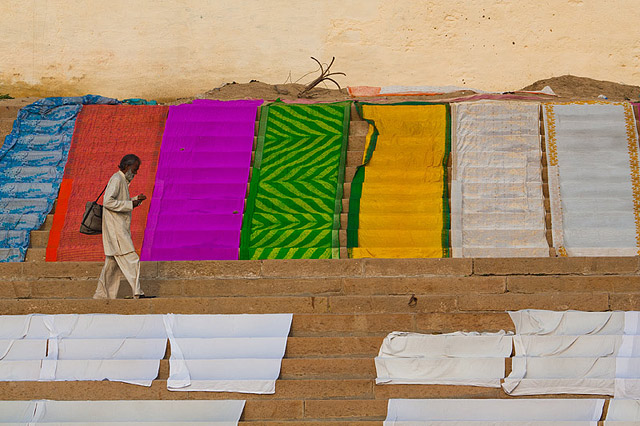
Life on the ghats spreads beyond appeasing the forces of the other world; it also makes space for emotions of the everyday life. Children played cricket on the narrow spaces. Washer men brought the dirty laundry from all over the town and permitted those clothes a good fortune of getting a wash in the Ganga. The saris spread on the steps for drying made a riot of colours along the ghats. Small shops invited the strollers to step down and relax with a cup of sugary chai and a loaf of bun. Street dogs lurked besides these shops hoping to steal a biscuit or two or wagging their tail begging for a piece of snack. Bank Mynas hopped around pilgrims looking for something to eat. Water buffaloes did what they are best at – idling in the water.
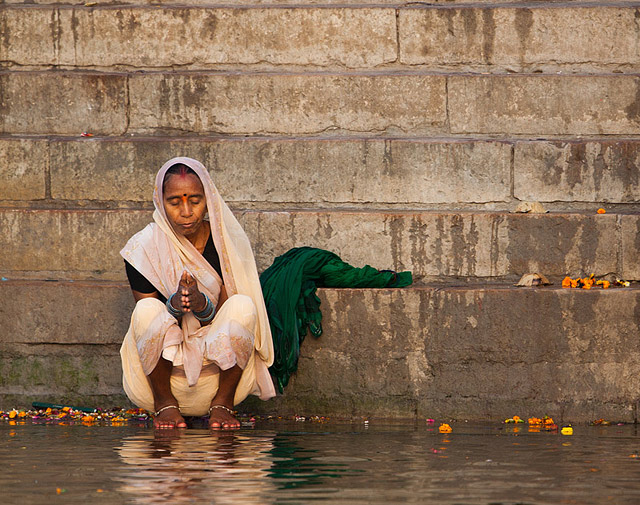
It is these ghats that have built a curiosity in the people world over. Tourists and photographers throng the city, some just to stop by and look, and some to experience the vibes of its faith. During the days I spent walking up and down the ghats, I met people from all over the world, each one with a different perspective. A French Photographer smiled at me and said “It’s incredible,” and shrugged at what he was seeing. An American who was a member of Hare Krishna community spoke of the city with great respect. An elderly man who spent his years in corporate boardroom mused that Varanasi has a charm to attract people and hold them back in its confines. Several tourists walked up and down with their cameras with an intention no more than to share their holiday pictures, without any wish to discover the secrets held in those steps leading to the river.
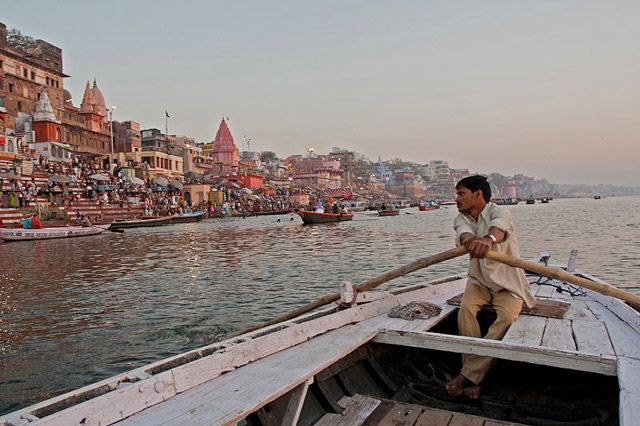
A morning boat ride on the Ganges gave me a cinemascopic view of the diversity on the ghats. Early morning sun bathed the ghats in an orange glow and a dash of freshness, as the pilgrims began descending the steps for the morning rituals. The disarray of the buildings behind the ghats have failed to evolve into an order with centuries of city’s evolution. Seen from a distance sitting on the boat, they are a farrago of structures spawning densely and irregularly. But to the other side of the river is something less predictable. Stranded on the expanse of the sandy eastern bank are the remains of the dead who are orphaned into the river from the burning ghats, now devoured by dogs and crows. The celebrated Ganges flows past all of them, accepting the contrast along its edges, not complaining even when the land that she gives life to treats her as a mere sewer, and at the same time looking at her with great reverence.
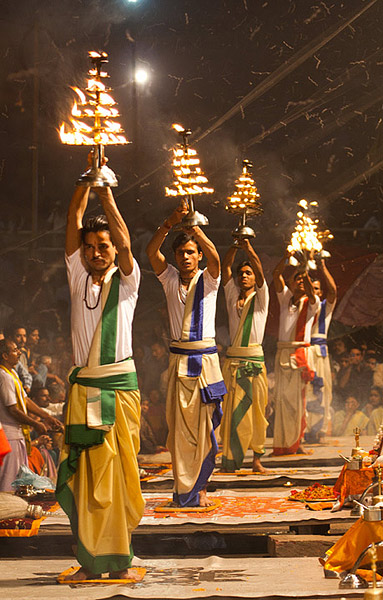
As I retreat from Varanasi, I muse on the opposites that the city divides itself into. It has a part that is outward looking, ambitious and growing along with the modern India in search of new wealth, striving to be a part of the new world. And spread near the river is another part that has refused to change with times, retaining an essence that is rooted in a strong belief system. In these ancient parts lies an indifference to everything worldly, and an attempt to escape from the everyday life by letting the cosmic forces take over mind, body and soul. It is this indifference that makes a pious pilgrim say that Ganga Maiya is intrinsically pure and can’t be polluted, when a curious tourists with a backpack questions about the sewer like state of the river. It is the unshakable belief that has resisted change that is sweeping the urban India everywhere else. In Mark Twain’s words, “For ages and ages the Hindoos have had absolute faith that the water of the Ganges was absolutely pure, could not be defiled by any contact whatsoever, and infallibly made pure and clean whatsoever thing touched it. They still believe it, and that is why they bathe in it and drink it, caring nothing for its seeming filthiness and the floating corpses.” Every word he said stands good even today, and probably continues to hold good for centuries to come. Varanasi doesn’t just belong to the past; it is eternal.
Walking towards the train station as I am ready to leave the city, I see the plush establishments that line the cantonment area in the opposite part of the city. As the wheels of my train start rolling away from Varanasi, I can’t help but remember the overused cliché – India is a land full of contrasts.